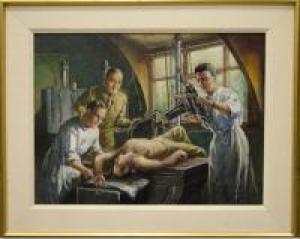
A good mystery novel, at its core, consists of interesting characters, a compelling plot, and puzzle-solving. In these respects, the job of an archivist mirrors that of a detective, as the archivist must reconstruct the pasts of people or objects from fragments of information. While such mysteries come in a variety of forms, the most common is determining the history, or provenance, of an item or collection.
Recently a series of paintings in the Medical Center Library’s Artwork Collection posed such a challenge. The paintings, done in 1944 by Frank Beresford, depict scenes of the U.S. Army 65th General Hospital Unit at work during World War II in the Eastern Theater of Operations (E.T.O.). Absent from the Library’s inventory of these works, however, were details about when and how they came to Duke.
A brief Internet search for Frank Beresford confirmed that he was a British painter who was active during World War II. Before the war, he was best known for his portraits of British royalty. During WWII, he was commissioned to paint for both the U.S. and British forces.
The 65th began as a reserve medical unit formed at Duke University by the School of Medicine Dean Wilburt Davison in 1940 to serve during World War II. The original unit was comprised of Duke doctors, nurses, and graduate students. When the unit was placed on active duty in July, 1942, their numbers grew as more nurses and enlisted men joined. Overseas they became one of the best army hospitals in the E.T.O., known for their high success rate and innovative practices. In all, the unit treated more than 17,250 patients during the war.
 The Archives houses the 65th General Hospital Collection, which consists of personal papers, records, and memorabilia of the unit. Also in these records are two folders containing correspondence between Frank Beresford and Dean Wilburt Davison. In July, 1945, Beresford sent several prints of his work, including the series of the 65th, to Davison along with a letter expressing his gratitude for the excellent medical care he received from the doctors and nurses of the 65th while in the E.T.O. He wrote, “Last year I was taken ill and by good fortune the Doctor sent me to the 65th General U.S. Army Hospital where I received every care and attention…I have a very high regard for [Major Haltom] and all the other brilliant Surgeons, Doctors and Nurses from ‘Duke’s.’”
The Archives houses the 65th General Hospital Collection, which consists of personal papers, records, and memorabilia of the unit. Also in these records are two folders containing correspondence between Frank Beresford and Dean Wilburt Davison. In July, 1945, Beresford sent several prints of his work, including the series of the 65th, to Davison along with a letter expressing his gratitude for the excellent medical care he received from the doctors and nurses of the 65th while in the E.T.O. He wrote, “Last year I was taken ill and by good fortune the Doctor sent me to the 65th General U.S. Army Hospital where I received every care and attention…I have a very high regard for [Major Haltom] and all the other brilliant Surgeons, Doctors and Nurses from ‘Duke’s.’”
Further inspection of the letters reveals that Beresford was a U.S. war correspondent as well as a painter, and also sent more artwork to Davison than just the series he did of the 65th. Davison and Beresford corresponded over a period of almost 15 years. In a letter from 1950, Davison offered to buy one of the original paintings in the series. It was not until 1959, however, that the Medical Center was able to buy the whole series from Beresford. In addition to the original paintings, Beresford sent Davison the original sketches. These sketches became part of the 65th General Hospital Unit Collection.
Researching these paintings reveals not only the rich history they have but the importance of record keeping to institutional memory. Fifty years ago, the origin of how these paintings came to Duke would not have been a mystery. Yet over time the details and knowledge of such events fade from memory. Until now, none of the Medical Center Library & Archives staff knew any more than the artist, title, and date for the paintings. Without the surviving correspondence, the provenance of these paintings would have remained a mystery.
To learn more about the Archives, please visit the Medical Center Archives Website or email dumc.archives@mc.duke.edu.
Submitted by Matt Shangler, Assistant Archivist, Medical Center Archives
